The AMD Ryzen 3 1300X and Ryzen 3 1200 CPU Review: Zen on a Budget
by Ian Cutress on July 27, 2017 9:30 AM EST- Posted in
- CPUs
- AMD
- Zen
- Ryzen
- Ryzen 3
- Ryzen 3 1300X
- Ryzen 3 1200
Benchmarking Performance: CPU Rendering Tests
Rendering tests are a long-time favorite of reviewers and benchmarkers, as the code used by rendering packages is usually highly optimized to squeeze every little bit of performance out. Sometimes rendering programs end up being heavily memory dependent as well - when you have that many threads flying about with a ton of data, having low latency memory can be key to everything. Here we take a few of the usual rendering packages under Windows 10, as well as a few new interesting benchmarks.
All of our benchmark results can also be found in our benchmark engine, Bench.
Corona 1.3: link
Corona is a standalone package designed to assist software like 3ds Max and Maya with photorealism via ray tracing. It's simple - shoot rays, get pixels. OK, it's more complicated than that, but the benchmark renders a fixed scene six times and offers results in terms of time and rays per second. The official benchmark tables list user submitted results in terms of time, however I feel rays per second is a better metric (in general, scores where higher is better seem to be easier to explain anyway). Corona likes to pile on the threads, so the results end up being very staggered based on thread count.
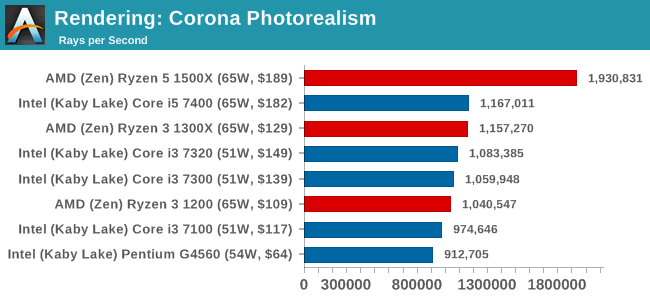
Blender 2.78: link
For a render that has been around for what seems like ages, Blender is still a highly popular tool. We managed to wrap up a standard workload into the February 5 nightly build of Blender and measure the time it takes to render the first frame of the scene. Being one of the bigger open source tools out there, it means both AMD and Intel work actively to help improve the codebase, for better or for worse on their own/each other's microarchitecture.
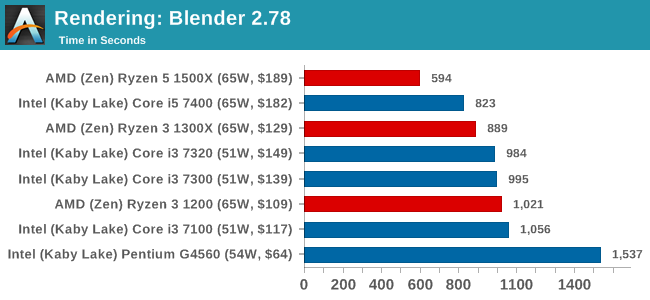
LuxMark v3.1: Link
As a synthetic, LuxMark might come across as somewhat arbitrary as a renderer, given that it's mainly used to test GPUs, but it does offer both an OpenCL and a standard C++ mode. In this instance, aside from seeing the comparison in each coding mode for cores and IPC, we also get to see the difference in performance moving from a C++ based code-stack to an OpenCL one with a CPU as the main host.
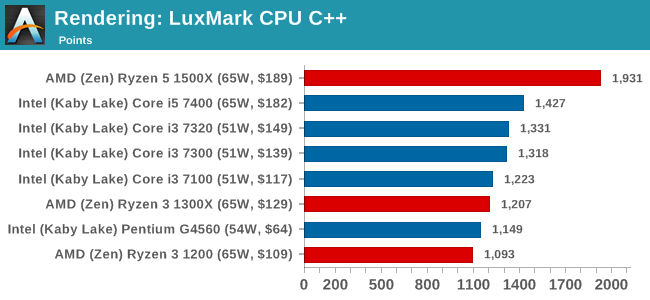

POV-Ray 3.7.1b4: link
Another regular benchmark in most suites, POV-Ray is another ray-tracer but has been around for many years. It just so happens that during the run up to AMD's Ryzen launch, the code base started to get active again with developers making changes to the code and pushing out updates. Our version and benchmarking started just before that was happening, but given time we will see where the POV-Ray code ends up and adjust in due course.
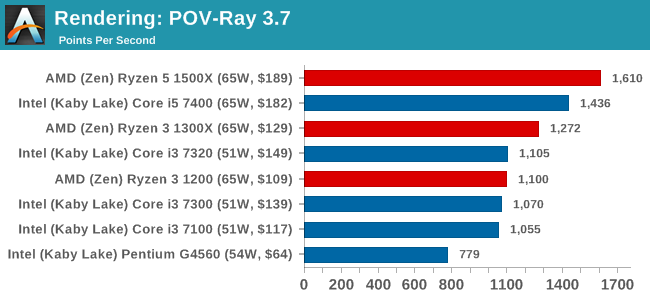
Cinebench R15: link
The latest version of CineBench has also become one of those 'used everywhere' benchmarks, particularly as an indicator of single thread performance. High IPC and high frequency gives performance in ST, whereas having good scaling and many cores is where the MT test wins out.
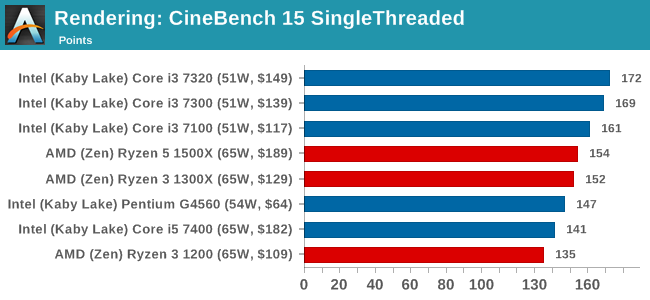
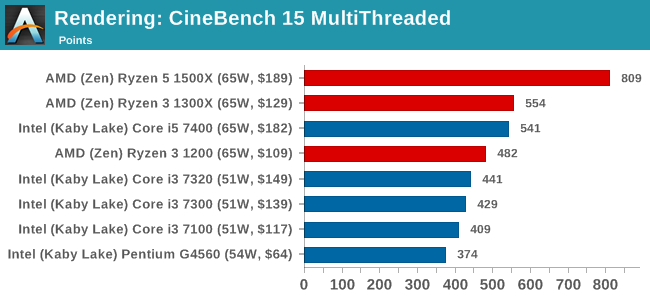










140 Comments
View All Comments
haukionkannel - Thursday, July 27, 2017 - link
You can install Ryzen 1200 and use Nvidia 1080ti and run games at 4K easily, so there is a point of these prosessors.There will be Ryzen based APU later in this or next year for Office computers and maybe even htpc usage and laptops. Those Are budget CPU for gaming and you can pair them as fast GPU as you like and still get reasonable good results!
The Intel 7700 is in the top, but if you run games at 4K I think that you can save a big deal by usin amd 1200 instead of Intel 7700! The difference is so small in speed and so big in money!
kaesden - Thursday, July 27, 2017 - link
dont forget that ryzen 1200 with a 1080ti could also have a 1700 dropped in down the line when budget allows, or when more cpu performance is needed. And the ryzen based APU's are coming eventually for those who just want basic integrated graphics. AMD isn't finished yet with their roll out.zodiacfml - Thursday, July 27, 2017 - link
The purpose is to make use/sell of disabled chips. This could be the reason why AMD and Nvidia started selling the new, lowest end discrete graphics cards. Desktop APUs will arrive early 2018.I wonder if AMD will ever have to cripple these Zen parts in the future as some articles mention they have high pretty good wields.
lefty2 - Thursday, July 27, 2017 - link
They aren't "making" a $100 CPU with no iGPU, they are just re-badging a $500 CPU. Much cheaper in research costs than having to design a new die. ...and the same logic applies to the 7700Kbennyg - Thursday, July 27, 2017 - link
I think the price/perf discussion should be a it broader in scope than just comparing CPU alone. The need to find or buy a GPU for the R3 compared to the Intel competition is a noticable omisson. Even the budgestest secondhandest GPUs will throw out the metrics of a $30 price comparison, but the extra graphics performance and/or features you may get from a dedicated GPU over iGPU should also be considered.bennyg - Thursday, July 27, 2017 - link
should be a *lot* broader. typoManch - Friday, July 28, 2017 - link
That's why these were tested with the higher end GPU's. To eliminate the IGP as a performance factor and compare CPU only. As you said, the extra performance you would get from even a low end discrete would be an unfair advantage for AMD. If you got one that was crappier than the IGP(if possible) then it would be an unfair advantage to Intel. It would be hard to decide which Discrete card would be the official stand in. On that note, doesn't AMD have discrete R7 cards that are paired with their APU's that are pretty much a copy of the IGP? They're not VEGA cores though so it wouldn't be a good way to predict the performance of the upcoming APU's. It would however give an idea as to what Bristol would have been using ZEN cores.extide - Saturday, July 29, 2017 - link
Latest AMD APU's are still construction cores (Excavator) with Polaris based graphics. Ryzen with Vega based will come later.Alexvrb - Thursday, July 27, 2017 - link
I don't know... maybe... gaming on a relatively small budget? Ryzen 3 plus a $150-200 graphics card is clearly better than an equivalent i3 build, plus they overclock even with a cheap B350 board.serendip - Friday, July 28, 2017 - link
For a cheapo gamer like me, Ryzen 3 + a $100 card is fine, but how big is that market anyway?AMD needs to go beyond servicing enthusiasts, it has to get OEMs to use Ryzen in cheap PCs for basic use in schools, homes and businesses. These segments won't bother going for Ryzen 5 or i5, they just want the cheapest computer available. AMD doesn't have a good name in the low end of the market because of its terrible APUs.